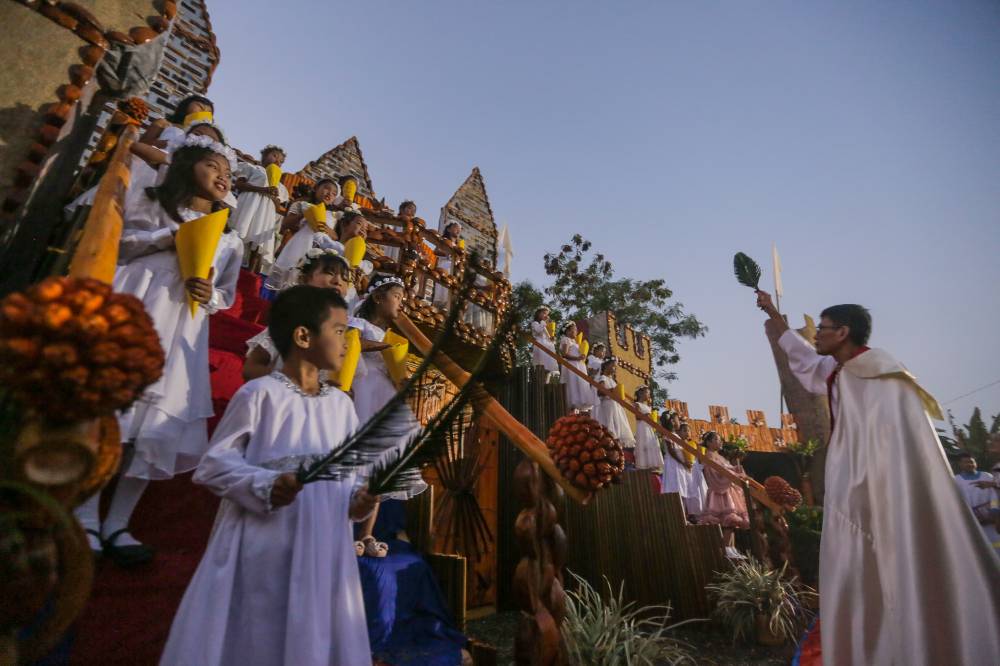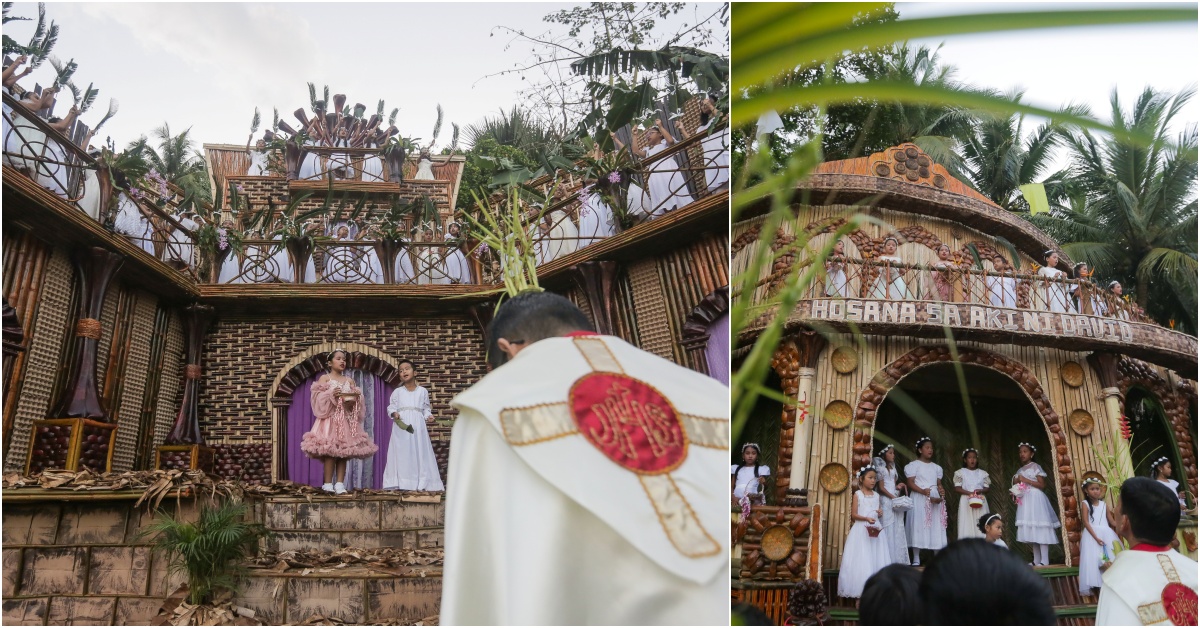In Catanduanes, ‘hosanahan’ still alive as a Lenten rite

STARTING HOLY WEEK | Children dressed as angels in Caramoran, Catanduanes, sing “Hosanna” on the platforms of “hosanahan,” a structure made of nipa leaves, coconut husks and bamboo, as part of a Palm Sunday practice in the town to remember the entry of Jesus Christ to Jerusalem. (Photo by MARK ALVIC ESPLANA / Inquirer Southern Luzon)
CARAMORAN, Catanduanes, Philippines — Five villages in this northwestern town of Catanduanes province continue to practice a unique Lenten tradition that locals claim has existed for at least a century.
Every Palm Sunday, Caramoran residents show off their best “hosanahan,” a structure built out of bamboo, nipa, coconut, and other materials they take from nearby forests or buy from the public market.
Though fierce, the competition remains friendly for the best-designed hosanahan (literally, “a place where ‘Hosanna’ is sung”) because all teams get the same cash prize as the winner, who will be announced on Good Friday.
The structures, which serve as platforms where young children dressed as angels sing the “Hosanna,” are designed like castles to imitate the buildings in Jerusalem during Jesus Christ’s triumphal entry to the city for the Passover.
The singing of “Hosanna” has a biblical basis, according to St. John the Baptist assistant parish priest, Fr. Ernie Tatualla.
Article continues after this advertisement“When Jesus entered Jerusalem, the people sang, ‘Hosanna to the Son of David’ to welcome Jesus as they waved leaves (or palm fronds),” he told the Inquirer in an interview.
Article continues after this advertisementThis year, the contest began at the chapel in Toytoy village after the palms were blessed at 5 a.m. on Palm Sunday.
Emma Salameña, 67, led the musicians and a group of children, some as young as 7 years old, as they stood on their hosanahan entry and sang a sorrowful version of “Hosanna.” From there, Salameña had to run to Baybay village, where participants performed a joyful version of the same song.
As they sang, the angels showered with flower devotees who were carrying handkerchiefs in which they placed the dried flowers and cut “tara,” an aromatic herb found in rice fields they picked up. Some angels were holding leaves of oliva palm, while others were carrying baskets full of dried flowers.
Some devotees keep the seeds of the tara for planting later on, believing that this will bode well for their harvest.
‘Via Crucis’ vs ‘hosanahan’
Unlike the “Via Crucis” (Way of the Cross), in which devotees trace the movements of Jesus Christ on the way to Calvary by praying at each station, in hosanahan, the parish priest visits the structures much like Jesus Christ entering Jerusalem while devotees join in the singing of “Hosanna.”
This Palm Sunday, Rev. Fr. Avelino Sualibio Jr., the St. John the Baptist parish priest, led the way to each hosanahan.
According to Catandungonan historian Ramon Sarmiento, it is not known when the tradition began.
“It is assumed that it started during the Spanish period,” he told the Inquirer.
Sarmiento noted that in the past, old folks would lay their veils on the priest’s path toward each hosanahan.
“Now they don’t do that because women don’t wear veils to church anymore,” he said, adding that hosanahan used to be built within the vicinity of the church, not along the streets.
READ: Marinduque gov asks gov’t staff to wear Morion costumes during Lent
After being used for five minutes of singing, the structures are then demolished by the residents who made them.
At this point, they are not called hosanahan, but “calvario” (calvary).
The volunteers must then rebuild the structure as stages for scenes from the Way of the Cross.
Tourism officer Reymond Sales Molod said that preparations for the contest to make the best hosanahan and calvario started two weeks before Palm Sunday.
Act of penitence
According to him, the act of tearing down the structures also serves as penitence for residents.
In Bothoan, residents were still working on their hosanahan at 7 p.m. on Saturday.
“You will see even the youngest volunteers are aware of what they are doing because they have observed their elders doing just that since they were little,” said Nona Surban, 57, the president of the barangay pastoral council in Bothoan village.
For teacher Adrian de Quiroz, 26, sourcing funds is a crucial first step for the team-up of villages Icanbato and Maysuran in making their entry for the competition.
As “cabo” (head) of the two areas, he serves as a youth leader in charge of managing preparations, especially in looking for funds.

COMMUNITY RITUAL A local priest blesses “palaspas” (palm fronds) waved by local children as residents of Caramoran, Catanduanes, mark Palm Sunday through a community ritual called “hosanahan” and “calvario” to start the Holy Week. —PHOTOS BY MARK ALVIC ESPLANA
He has shelled out P5,000 from his own pockets on top of the funds he solicited from politicians, coteachers and batchmates. The money is then used for materials for the hosanahan and snacks for volunteers.
De Quiroz said that former residents of Caramoran who now live outside Catanduanes—sometimes even as far away as New Zealand—send them money for the endeavor.
“Even when they are far away, they are still connected because this tradition is in our hearts,” he told the Inquirer.
In 2010, when he was in sixth grade, he also volunteered as an angel.
De Quiroz, who is a member of the LGBTQIA+ community in Caramoran, said that in the past, they could not join the calvario-making contest.
“But now, there is a twist,” he said. “Just like me. I am now a leader. I handle the funds, so everything is clean. We are known to be very creative. So, they are here. They are all present.”
Just a bonus
“As long as I am doing what I can do, I am all right with that,” De Quiroz said. “Winning is just a bonus.”
He said he would continue helping make their calvario until he retired. “I will keep doing it until the Lord takes me,” he told the Inquirer.
De Quiroz’s cousin, Joseph de Quiroz, 48, heads the design team in Baybay, another competing village.
“It feels great because in your mind, you are also making the sacrifices that Jesus Christ made,” Joseph said. “Everyone is a winner because everyone really worked hard.”
In Toytoy village, Rico del Barrio, 40, the youth president, was among the 50 volunteers for their entry.
In all the 10 years he has joined the competition, their village has yet to win, he said.
But he added that he was volunteering not because he wanted to compete, saying, “We inherited this from our ancestors and it is our way of repenting.”
Father Tatualla, who hails from Bato town, also in Catanduanes, said that residents of Caramoran had effectively practiced penitence by going to the mountains to gather materials for their hosanahan or calvario.
“It has a catechetical value. The calvario, the tableau, can be used to teach the catechesis of the Church,” he said. \